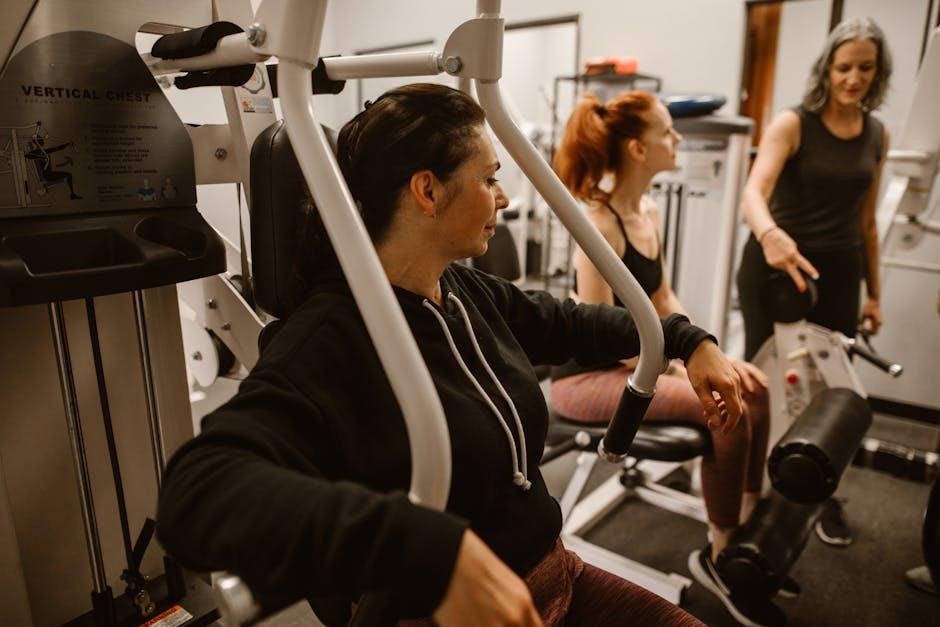
A hypermobility strength training program is specifically designed for individuals with joint hypermobility or conditions like Ehlers-Danlos Syndrome. It focuses on improving stability, reducing pain, and enhancing overall physical function through targeted exercises. The program emphasizes controlled movements and gradual progression to ensure safety and effectiveness in managing symptoms and improving quality of life;
Definition of Hypermobility and Its Implications
Hypermobility refers to joints moving beyond their normal range, often causing instability and pain. It can lead to chronic issues like joint subluxations and musculoskeletal discomfort. Connective tissues may weaken, affecting overall physical function and daily activities. Conditions such as Ehlers-Danlos Syndrome are closely linked. Effective management through targeted exercises is essential to improve joint stability and reduce pain, enhancing quality of life.
Importance of Strength Training for Hypermobility
Strength training is crucial for hypermobility as it enhances joint stability, reduces pain, and improves functional movement. It helps counteract the instability caused by overly flexible joints, particularly in conditions like Ehlers-Danlos Syndrome. By building muscle strength and endurance, individuals can better support their joints and improve overall physical function. A well-designed program can also prevent injuries and promote long-term mobility and independence, making it a cornerstone of hypermobility management.
Benefits of Strength Training for Hypermobility
Strength training improves joint stability, reduces pain, enhances muscle strength and endurance, and boosts proprioception. It helps manage hypermobility-related symptoms, improving functional performance and overall physical function effectively.
Improving Joint Stability and Reducing Pain
Strength training enhances joint stability by strengthening surrounding muscles, reducing excessive movement. Controlled exercises, such as planks and bridging, help alleviate pain by improving joint alignment and reducing strain on hypermobile areas. Consistent practice builds resilience, minimizing discomfort and promoting functional movement patterns. This approach is particularly beneficial for individuals with Ehlers-Danlos Syndrome or hypermobility spectrum disorders, helping them achieve greater comfort and mobility in daily activities.
Enhancing Muscle Strength and Endurance
Targeted strength exercises help build muscle endurance, crucial for hypermobility. Low-impact movements, such as glute bridges and modified push-ups, safely enhance muscle tone without overstraining joints. Gradual resistance increases strengthen connective tissues, improving joint stability. This approach reduces fatigue and enhances overall physical resilience, making daily activities easier and less painful for individuals with hypermobile conditions.
Boosting Proprioception and Body Awareness
Proprioceptive exercises, such as single-leg stands and balance drills, enhance body awareness and joint position sense. Techniques like Pilates and yoga focus on controlled movements, improving coordination and reducing instability. Strengthening core stability through plank variations and bridging also enhances proprioception, helping individuals with hypermobility better sense and control their body movements, leading to safer and more efficient physical activity patterns.

Key Principles of a Hypermobility Strength Training Program
The program emphasizes stability over flexibility, incorporates low-impact movements, and prioritizes controlled exercises to enhance joint support and minimize risk of injury or discomfort.
Focus on Stability Over Flexibility
Individuals with hypermobility often have excessive joint flexibility, making stability crucial. Strengthening the muscles around joints enhances support and reduces the risk of injury. Instead of focusing on stretching, exercises target core and muscle groups to create a stable foundation, improving joint function and overall movement control. This approach helps prevent overextension and promotes long-term joint health effectively.
Low-Impact and Controlled Movements
Low-impact and controlled movements are essential in hypermobility training to avoid joint stress. Exercises like modified squats, planks, and gentle resistance work are preferred. These movements minimize excessive strain while building strength and stability. Avoiding high-impact activities reduces injury risk, ensuring safe and effective progression in the program. This approach supports joint health and promotes sustainable physical improvement.
Incorporating Proprioceptive Exercises
Proprioceptive exercises enhance body awareness and joint stability, crucial for hypermobility. Techniques like single-leg stands, balance boards, and wobble cushions improve sensory feedback. These exercises strengthen the connection between muscles and the nervous system, reducing instability. Incorporating activities that challenge balance and coordination helps individuals better sense their body position, promoting safer movement and reducing injury risk. This focus on proprioception is vital for long-term stability and function.

Core Strengthening Exercises for Hypermobility
Core strengthening exercises are essential for improving spinal stability, posture, and overall physical function in individuals with hypermobility, helping to manage symptoms effectively.
Plank Variations for Core Stability
Plank variations are excellent for enhancing core stability in hypermobile individuals. Modified planks, such as forearm planks or knee planks, reduce strain on hypermobile joints while strengthening abdominal muscles. These exercises improve posture, reduce back pain, and promote overall spinal stability without overextending the joints, making them a safe and effective choice for hypermobility strength training programs.
Bridging and Pelvic Floor Engagement
Bridging exercises strengthen the lower back and glutes while engaging the pelvic floor, essential for hypermobile individuals. Gentle movements, like pelvic tilts and slow lifts, improve stability without overextending joints. This enhances core support, reduces pelvic instability, and promotes proper posture, making it a cornerstone of hypermobility strength training for long-term joint health and functionality.

Lower Body Strength Training
Strength training for the lower body focuses on safe, low-impact exercises to enhance stability and muscle strength, reducing joint instability and improving overall functional movement patterns.
Glute Strengthening Exercises
Glute strengthening exercises are essential for improving joint stability and reducing pain in individuals with hypermobility. Controlled movements like glute bridges, side-lying leg lifts, and bird dogs target the glutes without overstraining joints. These exercises help enhance muscle endurance and promote proper alignment, reducing the risk of instability and discomfort. They are often performed with core engagement to ensure stability and maximize effectiveness, making them a cornerstone of lower body strength training for hypermobile individuals.
Safe Squats and Lunges for Hypermobility
Squats and lunges can be safely modified for hypermobility by focusing on controlled movements and proper form. Using support, such as a chair or wall, can help maintain stability. Shallow depths and slower tempos reduce joint stress. Prioritizing core engagement and avoiding excessive knee or hip flexion minimizes risk of instability. These exercises strengthen the lower body while promoting joint health and pain-free movement, essential for hypermobile individuals.

Upper Body Strength Training
Upper body strength training for hypermobility focuses on building stability and endurance without compromising joint health. Modified push-ups, rows, and scapular exercises are key. Emphasizing controlled movements and proper form helps avoid instability. Strengthening shoulder and core muscles enhances overall posture and reduces fatigue. This approach ensures safe and effective progression, catering to the unique needs of hypermobile individuals while improving functional strength and reducing pain.
Modified Push-Ups and Rows
Modified push-ups and rows are essential for upper body strength in hypermobility. Use knee support or wall push-ups to reduce joint strain. Gentle rows with light weights or resistance bands strengthen the back without overextending joints. These exercises improve posture, reduce shoulder fatigue, and build stability. Controlled movements and proper form are crucial to avoid discomfort and ensure effectiveness in strengthening muscles safely.
Scapular Stability Exercises
Scapular stability exercises are crucial for hypermobility, focusing on strengthening shoulder muscles. Techniques like wall slides, scapular push-ups, and bird-dog exercises improve posture and reduce shoulder fatigue. These movements enhance joint stability and prevent overextension. Gentle resistance with bands or light weights can be added for progression. Proper form and controlled movements are essential to avoid discomfort and promote long-term shoulder health and functionality.
Flexibility and Mobility Considerations
Balancing flexibility and stability is key for hypermobility. Gentle stretching techniques and dynamic mobility drills help maintain range of motion without causing instability. Avoid overstretching to prevent subluxations.
Gentle Stretching Techniques
Gentle stretching is crucial for hypermobility to maintain range of motion without instability. Techniques like static stretches or dynamic drills should be done cautiously, avoiding overstretching. Focus on controlled movements to enhance flexibility while preserving joint stability. These exercises help prevent muscle imbalances and reduce the risk of subluxations. Stretching should be limited in duration and frequency to avoid exceeding joint limits, ensuring safety and effectiveness.
Dynamic Mobility Drills
Dynamic mobility drills are essential for improving joint function and proprioception in hypermobility. These active movements, such as leg swings or arm circles, enhance flexibility and coordination without overextending joints. Performed within a comfortable range, they help maintain joint stability while promoting better movement patterns. Examples include cat-cow stretches or gentle hip rotations, which are low-impact and controlled, making them safe for individuals with hypermobility or EDS.
Multidisciplinary Approach to Training
A multidisciplinary approach combines physical therapy, Pilates, and yoga to address hypermobility. This integrated method ensures comprehensive care, improving strength, stability, and overall well-being effectively.
Role of Physical Therapy in Program Design
Physical therapy plays a crucial role in designing hypermobility strength programs, focusing on personalized exercises to enhance stability and strength. Therapists assess individual needs, ensuring exercises are modified to prevent injury and promote proper movement patterns. They often incorporate activities like bridging and pelvic floor engagement to improve core stability, which is essential for managing hypermobility effectively.
Incorporating Pilates and Yoga
Pilates and yoga are excellent for improving core strength, body awareness, and flexibility in individuals with hypermobility. These practices emphasize controlled movements and proper alignment, which help stabilize joints. Gentle stretches and dynamic mobility drills enhance proprioception, reducing the risk of injury. Modified exercises cater to hypermobile individuals, focusing on strength without overextending joints, making them safe and effective additions to a strength training program.
Progression and Monitoring of the Program
Progression involves gradually increasing exercise intensity to build strength and stability without causing instability. Monitoring ensures exercises are pain-free and joints remain stable, adjusting as needed for safety and effectiveness.
Gradual Increase in Intensity
A gradual increase in intensity is crucial to avoid overloading joints. Start with low-resistance exercises, progressively adding weight or reps as strength improves. This approach helps build resilience without causing instability or pain, ensuring sustainable progress and long-term joint health for individuals with hypermobility. Consistency and patience are key to achieving effective results safely.
Monitoring for Pain or Instability
Monitoring for pain or instability is essential to ensure safe progression in a hypermobility strength training program. Individuals should listen to their bodies, adjusting exercises if discomfort arises. Activities causing pain or joint instability should be avoided or modified. Regular assessments with healthcare professionals help tailor the program, promoting consistency and gradual progress without compromising joint health or overall well-being.
A well-structured hypermobility strength training program can significantly improve joint stability, reduce pain, and enhance overall function. Consistency, professional guidance, and careful monitoring are key. Prioritize low-impact exercises, gradual progression, and proper form to avoid instability. Collaborate with physical therapists or specialists to tailor the program to individual needs, ensuring sustainable progress and improved quality of life for those with hypermobility or related conditions.
 king of the underworld rj kane pdf
king of the underworld rj kane pdf  mark cousins the story of film pdf
mark cousins the story of film pdf  algebra workbook pdf
algebra workbook pdf  the other end of the leash pdf
the other end of the leash pdf  schedule pipe chart pdf
schedule pipe chart pdf  l tec 225 mig welder parts manual pdf
l tec 225 mig welder parts manual pdf  merlin home transmitter manual
merlin home transmitter manual  contrat de sous-location québec pdf
contrat de sous-location québec pdf